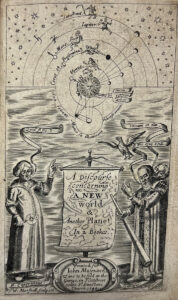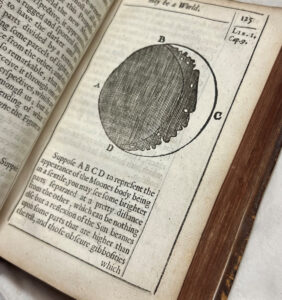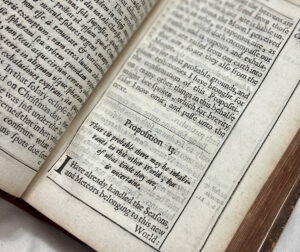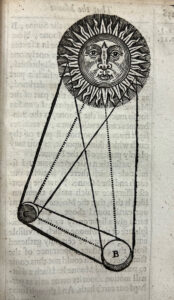By Oliver Rickwood
 How often do you dream about travelling to the Moon? In the 21st century it is far from a ridiculous fantasy; since Neil Armstong’s first steps on the lunar surface in 1969 a further eleven people have accomplished the feat. However, it may come as a surprise that 17th century philosophers and scientists were equally captivated by this same possibility. Natural philosopher John Wilkins (1614-1662) not only considered how we could travel to the Moon, but also explained the existence of an entire civilisation he believed was already living there in his 1638 book, The Discovery of a World in the Moone; or A Discourse Tending to Prove, That ’Tis Probable There May Be Another Habitable World in That Planet. He describes the character of the Moon in 14 propositions, combining his own observations and widely accepted cosmology to draw conclusions about the nature of this new world and its people.
How often do you dream about travelling to the Moon? In the 21st century it is far from a ridiculous fantasy; since Neil Armstong’s first steps on the lunar surface in 1969 a further eleven people have accomplished the feat. However, it may come as a surprise that 17th century philosophers and scientists were equally captivated by this same possibility. Natural philosopher John Wilkins (1614-1662) not only considered how we could travel to the Moon, but also explained the existence of an entire civilisation he believed was already living there in his 1638 book, The Discovery of a World in the Moone; or A Discourse Tending to Prove, That ’Tis Probable There May Be Another Habitable World in That Planet. He describes the character of the Moon in 14 propositions, combining his own observations and widely accepted cosmology to draw conclusions about the nature of this new world and its people.
The many possibilities unlocked by advancing science fascinated the public in the mid-17th century; Wilkins’ book was hugely popular and found on most London bookstalls in the early 1640s. The physical properties of the Cathedral Library’s copy as a plain, leather-bound octavo meant that it was easy to read on the go, not published exclusively for academics or the upper class but rather anyone captivated by the thought of space travel. The title page is far from plain; its elaborate design depicts astronomers Johannes Kepler, Galilei Galileo, and Nicolaus Copernicus gesturing towards a diagram of the solar system. This page confirms Wilkins’ sources of scientific knowledge: he is assured in ‘having read Plutarch, Galileo and Kepler’, and finding so many of his own thoughts ‘confirmed’ by these great philosophers and astronomers, a group that he labelled as a source of ‘such strong authority’.
 The first four propositions of Wilkins’ text are simple observations of the Moon and the behaviour of light, arguing that ‘the Moone is a solid, compacted, opacious body’ that ‘cannot shine at all’. Galileo’s theories on the motion of the planets concur with this. If Wilkins’ argument is built upon foundations of respected Renaissance astrophysics, why does the introduction to his text dismiss it as ‘the fruit of some lighter studies’, to be read in the reader’s ‘leisure hours’?
The first four propositions of Wilkins’ text are simple observations of the Moon and the behaviour of light, arguing that ‘the Moone is a solid, compacted, opacious body’ that ‘cannot shine at all’. Galileo’s theories on the motion of the planets concur with this. If Wilkins’ argument is built upon foundations of respected Renaissance astrophysics, why does the introduction to his text dismiss it as ‘the fruit of some lighter studies’, to be read in the reader’s ‘leisure hours’?
Wilkins, eventually a Bishop and highly respected member of the Anglican Church, was ordained a priest in February 1638, the year of the book’s publication. Ideas of lunar civilisations posed questions directly challenging the doctrine of the Church and Wilkins had to decide how to engage with these whilst remaining a safe distance from religious disgrace. Are the lunar inhabitants from the ‘seed of Adam’? Are they fallen, or in a ‘blessed estate’? What does this mean for their ‘salvation’?
Wilkins does not completely avoid these issues and yet does not explicitly address them; he repeatedly uses ‘perhaps’ and published the book anonymously, although the authorship quickly became widely known.
 Historian David Cressy points out that through inconclusive statements, Wilkins was ‘familiar with the reigns of censorship’: ‘it is probable there may be inhabitants in this other world, but of what kind they are is uncertain’. Wilkins does, however, overtly claim that a belief in the plurality of worlds ‘doth not contradict any principle of reason or faith’. Clergymen, such as Alexander Ross (1590- 1654), disagreed, labelling the book, ‘both absurd and dangerous for men’s souls, and the peace of the church’. They believed that Wilkins had amplified complex religious debates.
Historian David Cressy points out that through inconclusive statements, Wilkins was ‘familiar with the reigns of censorship’: ‘it is probable there may be inhabitants in this other world, but of what kind they are is uncertain’. Wilkins does, however, overtly claim that a belief in the plurality of worlds ‘doth not contradict any principle of reason or faith’. Clergymen, such as Alexander Ross (1590- 1654), disagreed, labelling the book, ‘both absurd and dangerous for men’s souls, and the peace of the church’. They believed that Wilkins had amplified complex religious debates.

Wilkins directly addresses his sceptics, contending that explorer Christopher Columbus’ contemporaries laughed ‘when he promised to discover another part of the earth’ and that ‘other truths have been formerly accounted as ridiculous as this’. Discourse around expeditions to discover the Antipodes and the Americas, such as those carried out by Columbus, was mirrored in narratives depicting journeys to the Moon; William Godwin’s The Man in the Moone (1638) does exactly this, telling the story of an explorer who discovers a civilised society on the lunar surface. An important aspect of Wilkins’ text is its conversation with not only scientific theory, but scientific fiction of the time. After reading Godwin’s story, Wilkins republished his book in 1640, and in a newly written conclusion his speculation about how to reach the lunar people had more range and force: ‘I do upon good grounds affirm it possible to make a flying chariot’, a reference to the chariot that flew the Godwin’s protagonist to the Moon.
Wilkins does not provide definitive answers to questions of religion and, therefore, the significance of his book lies not entirely in its reference to scientific theory, or conversations with literature of similar lunar fantasies, but rather in its depiction of a century old interest in the possibility of life on the Moon and a desire to walk upon it. When Neil Armstrong finally conquered this in 1969, he proved Wilkins true – that one day there may be a ‘meanes invented of journeying to the Moone, and how happy shall they be, that are first successful in this attempt’.